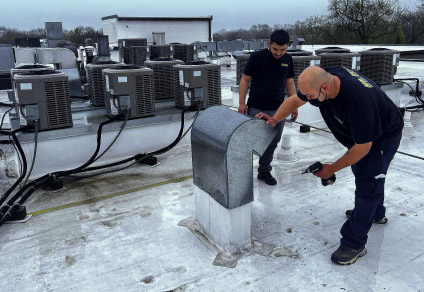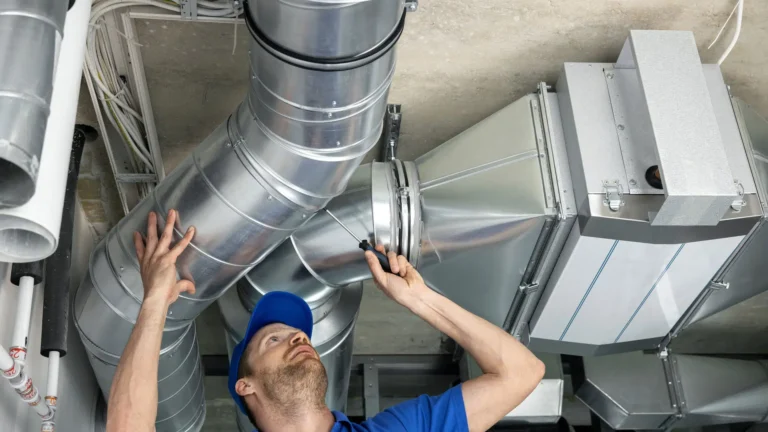Commercial Air Duct Cleaning Costs: Investment or Expense?

You’re staring at another monthly utility bill that seems to climb higher each quarter, and your office manager just handed you a stack of sick leave requests that’s thicker than your morning coffee is strong. Meanwhile, that persistent “stuffy air” complaint from employees has evolved into whispered conversations about headaches and fatigue around the water cooler. As a business owner or facility manager, you’re caught between the rock of operational costs and the hard place of employee satisfaction – and frankly, you’re wondering if there’s a connection between your building’s air quality and these mounting expenses.
Here’s where smart facility management meets bottom-line thinking: commercial air duct cleaning isn’t just a maintenance checkbox – it’s a strategic investment that pays measurable dividends. We’ve seen businesses slash their energy costs by 15-20% within months of professional duct cleaning, while simultaneously watching their employee sick days drop and productivity soar. The science is straightforward: clean ducts mean efficient HVAC systems, better air circulation, and healthier indoor environments that directly impact your operational costs and workforce performance. When you treat Air Duct Cleaning as a business investment rather than an expense, you unlock a cascade of financial benefits that compound over time.
Why Smart Business Owners Are Rethinking Air Duct Maintenance
Walk into any thriving commercial space, and you’ll notice something immediately: the air feels fresh, employees seem energized, and there’s an almost imperceptible hum of efficiency. What you can’t see are the clean air ducts working behind the scenes, quietly delivering measurable returns on investment that would make any CFO smile.
The old-school approach treated duct cleaning as reactive maintenance – something you did when problems became obvious. But forward-thinking businesses have flipped this script entirely. They’re discovering that proactive duct maintenance creates a ripple effect of cost savings and operational improvements that far exceed the initial service investment.
The Hidden Costs of Dirty Commercial Air Ducts
Energy Waste That Drains Your Budget
Your HVAC system is essentially the lungs of your building, and just like human lungs, when they’re clogged, everything works harder. We regularly find commercial systems operating at 60-70% efficiency simply because accumulated debris forces equipment to run longer cycles to achieve the same temperature control.
Think about it this way: if your delivery truck’s air filter was completely clogged, you wouldn’t be surprised when fuel costs skyrocketed. The same principle applies to your building’s air circulation system, except the “fuel” is electricity, and the waste happens 24/7.
The Productivity Drain You Can’t Afford
Poor indoor air quality doesn’t just make employees uncomfortable – it literally costs you money in measurable ways. Studies consistently show that workers in buildings with superior air quality demonstrate 6-9% higher productivity rates compared to those breathing recycled, contaminated air.
When your team is dealing with afternoon fatigue, persistent headaches, or that “brain fog” feeling, they’re not performing at their peak potential. We’ve watched businesses transform their workplace atmosphere simply by addressing the air quality foundation.
Equipment Replacement: The Expensive Surprise
Here’s a reality check that hits many business owners unexpectedly: dirty ductwork dramatically shortens HVAC equipment lifespan. Commercial HVAC systems represent significant capital investments, often ranging from $15,000 to $50,000 or more for comprehensive installations.
When dust, debris, and contaminants circulate through your system continuously, they create additional wear on motors, filters, and mechanical components. What should be a 15-20 year equipment lifecycle often shrinks to 8-12 years, forcing premature replacement costs that could have been avoided.
Calculating Your Commercial Air Duct Cleaning ROI
Energy Savings: The Monthly Gift That Keeps Giving
Let’s talk numbers that matter to your bottom line. Commercial energy savings from professional duct cleaning typically range from 15-25% on heating and cooling costs, with some businesses seeing even higher reductions depending on their system’s initial condition.
For a mid-sized office building spending $3,000 monthly on HVAC energy costs, a 20% reduction translates to $600 in monthly savings – that’s $7,200 annually. Over a five-year period, you’re looking at $36,000 in energy cost avoidance, all from a service investment that typically costs significantly less than one month’s utility bill.
Employee Productivity and Indoor Air Quality: The Multiplier Effect
The business case for clean air goes far beyond comfort – it’s about unlocking human potential. When employees aren’t battling fatigue, allergies, or concentration issues caused by poor air quality, their output naturally increases.
Consider a scenario where improved air quality boosts productivity by just 5% across a team of 25 employees earning an average of $50,000 annually. That productivity gain represents $62,500 in additional value creation per year – and we’re being conservative with these numbers.
Reduced Sick Days Through Better Air Quality Management
The connection between indoor air quality and employee health isn’t just theoretical – it’s documented and measurable. Businesses that prioritize air quality management consistently report 10-15% fewer sick days compared to those with neglected ventilation systems.
If your company averages 8 sick days per employee annually, and improved air quality reduces that to 6.5 days, you’ve gained 1.5 productive days per person. For a 25-person team, that’s 37.5 additional productive days each year – equivalent to nearly two weeks of additional workforce availability.
Long-Term Business Benefits Beyond Immediate Savings
Equipment Downtime Prevention Through Preventive Duct Maintenance
Nothing disrupts business operations quite like an unexpected HVAC failure during peak season. Preventive duct maintenance acts as insurance against these costly interruptions, keeping your systems running smoothly when you need them most.
We’ve seen too many businesses learn this lesson the hard way – dealing with emergency repairs, uncomfortable working conditions, and lost productivity because they treated duct cleaning as optional rather than essential. The cost of prevention is always less than the cost of crisis management.
Commercial Lease Requirements: Staying Ahead of Compliance
Modern commercial lease requirements increasingly include specific air quality maintenance clauses that tenants must meet. Property managers and building owners are recognizing that air quality directly impacts tenant satisfaction and retention rates.
By maintaining clean ductwork proactively, you’re not just meeting lease obligations – you’re positioning yourself as a preferred tenant who takes building stewardship seriously. This can translate into better lease terms, renewal preferences, and stronger landlord relationships.
Tax Deductions and Business Expenses: Maximizing Your Investment
Professional duct cleaning services qualify as legitimate business expenses for tax purposes, and in many cases, you can deduct the full cost in the year of service. Some businesses may also qualify for additional deductions related to indoor air quality improvements or energy efficiency upgrades.
Work with your tax professional to understand how duct cleaning investments fit into your overall tax strategy. The combination of immediate operational savings and potential tax benefits creates a compelling financial picture.
Making the Smart Investment Decision
The question isn’t whether you can afford commercial air duct cleaning – it’s whether you can afford to postpone it any longer. When you add up energy savings, improved productivity, reduced sick days, and extended equipment life, the return on investment becomes undeniable.
Smart business owners understand that the buildings housing their operations are complex systems requiring strategic maintenance. Just as you wouldn’t skip oil changes on your company vehicles, neglecting your building’s respiratory system is a false economy that costs more in the long run.
The businesses thriving in today’s competitive landscape are those that recognize air quality as a foundational element of operational efficiency. They’re investing in their people, their equipment, and their long-term success through professional duct maintenance that pays dividends month after month, year after year.


